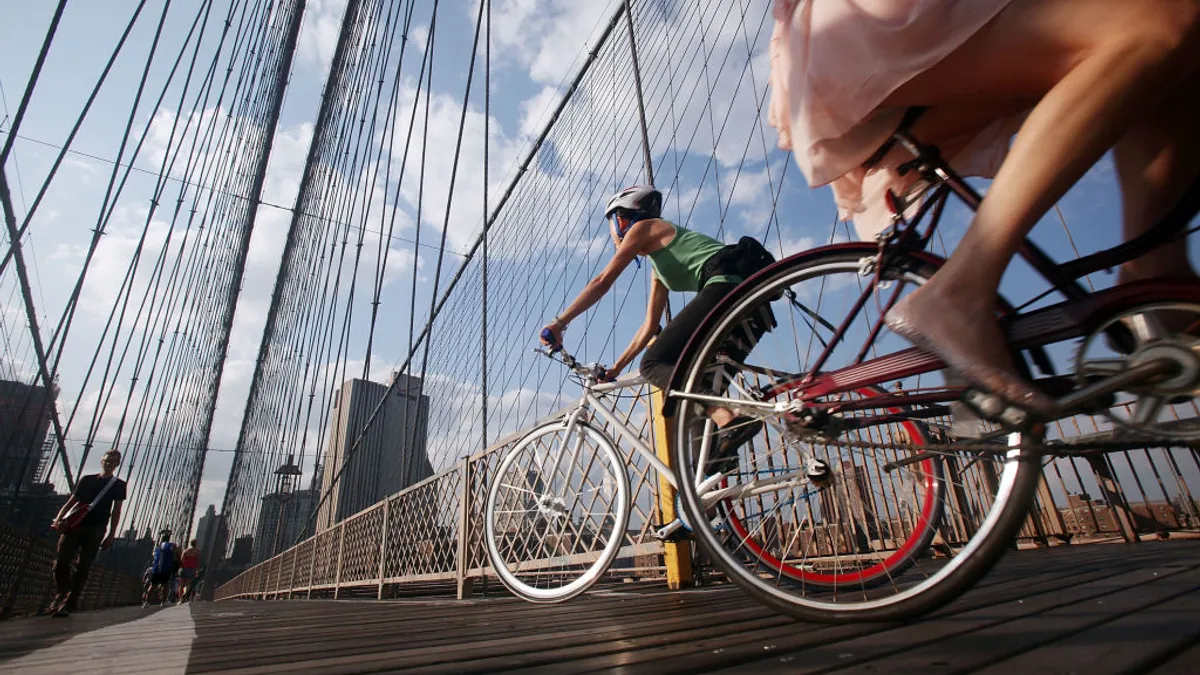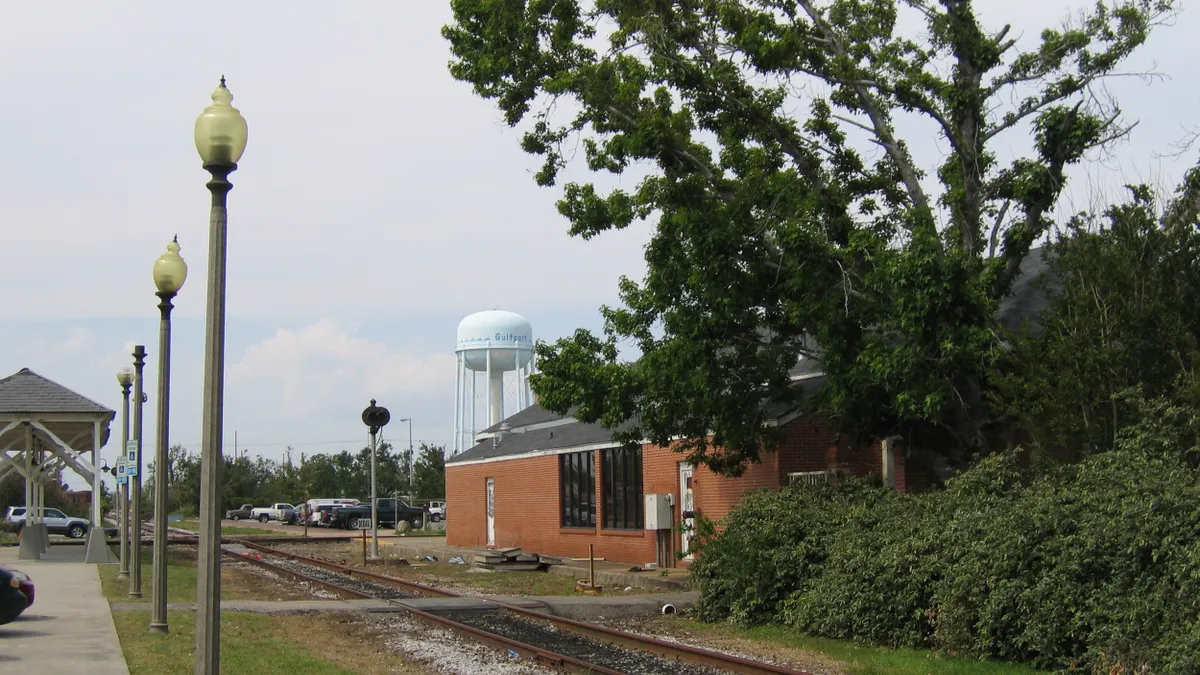In mid-September, bicycle advocates and members of the Bill de Blasio administration gathered on the Brooklyn Bridge to celebrate the first reconfiguration of the landmark in more than 70 years. In an event de Blasio called “a symbol of New York City fully embracing a sustainable future and striking a blow against car culture,” the city unveiled a protected bike lane replacing a lane of traffic long given over to cars.
Now bicyclists will be able to ride in a dedicated lane and won’t have to battle with pedestrians and picture-taking tourists to cross the East River between Brooklyn and lower Manhattan, a crucial step to the city’s promise of a fully connected, five-borough bike network.
“Without bike-friendly infrastructure on bridges, commuting across boroughs just isn’t possible,” said Juan Restrepo, senior organizer at New York-based Transportation Alternatives. “We’re working on a citywide network that mimics the highway system for the U.S. Connectivity is key.”
This transformation is the first reconfiguration of the iconic bridge since trolley tracks were permanently removed in 1950 (????via @nycrecords)
— NYC DOT (@NYC_DOT) September 14, 2021
“This is a historic moment as we work to get New Yorkers out of their cars & promote sustainable modes of transportation” -Cmsr Gutman pic.twitter.com/4BQBZlTT1M
The redesigned Brooklyn Bridge is part of an estimated 30 miles of bike lane New York City planned to add in 2021, the most by the city in a single year (the previous record was 2020's 28.6 miles.) While car buying boomed during the COVID-19 pandemic, bicycling has as well. That's prompted cities to take a harder look at turning piecemeal bike infrastructure into robust networks, with support from the Biden administration.
Caron Whitaker, deputy executive director of the League of American Bicyclists, said the administration's push for climate-friendly transportation and public interest in biking have helped made bike infrastructure an easier sell — after decades of it being relegated to a novelty with just a small percentage of transportation funding.
“Cities see the benefit of biking and are looking for more ways to accommodate it, especially after COVID,” said Whitaker. “Certainly we’re seeing a lot of interest from the administration in terms of promoting complete streets and improving safety and equity.”
The de Blasio administration's blitz to turn over some roadway space to bikers and pedestrians includes establishing "Bike Boulevards” with slow vehicular speeds and limited volumes across all five boroughs. Putting bike lanes on bridges, however, is more difficult. Some bridges are controlled by the city, while others by the state-owned Metropolitan Transportation Authority. As a heavily trafficked hub and tourist attraction that accommodated more than 116,000 vehicles, 30,000 pedestrians and 3,000 cyclists each day before the pandemic, closing off the city-controlled Brooklyn Bridge for construction was a challenge.
The new path cordons off the previous car lane with additional fencing and new barrier segments. The promenade that bikes and pedestrians previously shared now can handle more people without bikes sharing the same space.
“Some of the conversations we see in other cities are focused on [adding] additional lanes or parts to the bridge, which is much more expensive than working with existing infrastructure,” Restrepo said. “This new path is not just an incredible accomplishment in reallocating road space, but also a template for what could be done across other bridges in the city and in the US.”
Some other cities are similarly using the renewed interest in biking to boost their existing networks. Chicago officials, for example, announced in September the city plans to spend $17 million to add 100 miles of new bike lanes by the end of 2022, bringing the total mileage of bike lanes in the city to nearly 400. Seattle built 45 miles of bike lanes from 2016 through 2020 as part of a master plan to create a 100-mile network across the city.
In Washington, D.C., the September opening of the $480 million Frederick Douglass Memorial Bridge across the Anacostia River also represented a leap forward for bike connectivity. The new bridge, the District’s largest public infrastructure project to date, replaces an outdated bridge with a larger structure that includes a multiuse path for pedestrians and bikers.
The planning process to replace the original Frederick Douglass Memorial Bridge, which the district declared functionally obsolete, began over a decade ago. Bike advocates quickly embraced the project as an opportunity to create a safe crossing between two largely disconnected neighborhoods, said Colin Browne, director of communications for the Washington Area Bicyclist Association. Now, he says, the bridge “closes a big gap” in the National Capital Trail Network, a plan for a 1,400-mile network of off-street trails in D.C., Maryland and Virginia adopted last year by the Metropolitan Washington Council of Governments’ Transportation Planning Board.
Browne said the project also represents a step forward in management in a region where projects typically require working across city, county, state and federal governments.
“Usually as a bike-ped organization, you’re talking to planners who are a small part of the decision-making apparatus,” he said. “In this project, they had it figured out from the beginning. We’re seeing that the transportation agency has incorporated the climate and safety goals related to bicycle and pedestrian planning more broadly.”
Advocates said the budget reconciliation and bipartisan infrastructure bill that Congress is weighing could offer another funding boost.
The budget bill language passed by the House Transportation and Infrastructure Committee contains $4 billion for community climate incentive grants, with $3 billion reserved for city and regional governments. That, combined with a greenhouse gas performance metric program, could offer a valuable funding source for projects that promote biking and walking over driving. Reports say the overall budget bill could shrink, meaning the transportation provisions could be reduced.
In addition, the $1 trillion infrastructure bill increases funding for the Transportation Department's program funding non-driving infrastructure by 60% over five years for a total of $7.2 billion in that time. Under another provision in the bill, states that have higher road fatality rates would have to invest more in safer alternatives. Even a $12.5 billion bridge repair program has a requirement that projects applying for federal funding consider nonvehicle use of bridges, except when cost-prohibitive.
“The fact that we’re seeing more money being pushed to the city and local level is exciting,” said the League of American Bicyclists’ Whitaker. “We tend to see a lot more innovation at the local level, so we want the government to encourage and leverage that.”
More infrastructure can, in turn, lead to more biking: A study published in April in the Proceedings of the National Academy of Sciences that examined European cities found that cycling increased up to 48% more in cities, on average, where new bike infrastructure was added compared with cities without new lanes.
As Transportation Alternatives’ Restrepo eyes the future, he says New York City has plenty of potential for more bike infrastructure. De Blasio has said he’ll add bike lanes to the 1.4-mile Queensboro bridge. Eric Adams, the Democratic nominee for mayor, who is heavily favored to win in November, is an avid cyclist and pledged to build 300 new miles of protected bike lanes.
“For us, every single bridge should be accessible by bike and foot and part of a wider network,” Restrepo said. “We want to see our city moving towards a more sustainable future that really highlights bicycling.”
Correction: A previous version of this article misattributed comments from a Transportation Alternatives representative. Those comments were made by Senior Organizer Juan Restrepo.


















